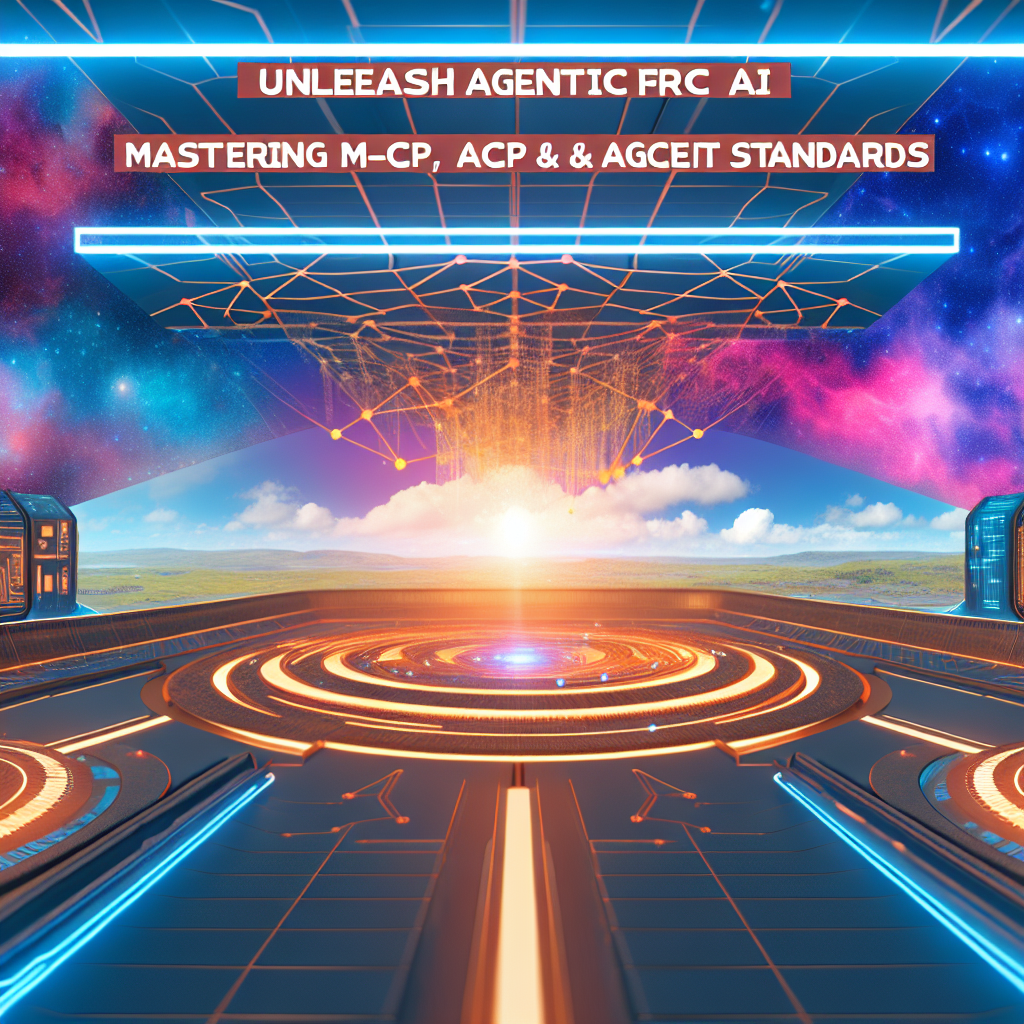The Brutal Truth: Why Your Enterprise AI Pilots Keep Failing (And How to Fix It)
Let’s be direct. For years, you’ve heard the promises of Artificial Intelligence transforming your business. As a CIO or IT leader, you’ve probably also lived the frustrating reality: endless pilots, shiny prototypes, grand ideas that just… fizzled out. It felt like trying to build a high-performance engine with parts from a dozen different, incompatible manufacturers. A colossal waste of time, money, and momentum.
Here’s the inconvenient truth: the game is rigged against you when there’s no common language. But a quiet, yet powerful, revolution is brewing. The solution isn’t more hype; it’s something foundational, something strategic: open protocols. These aren’t technical footnotes. They are the unsung heroes poised to supercharge AI adoption in the enterprise, making it simpler, standardized, and finally delivering on its grand promise.
Stop Wasting Millions: The Hidden Trap of Fragmented Enterprise AI
For too long, integrating AI into core business operations has been a nightmare. Every AI model, every agent, every specialized tool spoke a different dialect. This fragmentation isn’t just an annoyance; it’s a direct threat to your bottom line and your strategic vision. Consider the crippling consequences:
- Vendor Lock-in: Commit to one vendor’s AI, and you’re tied to their ecosystem. Want a better component? Good luck. You’re effectively trapped, stifling innovation and draining budgets.
- Integration Headaches: Connecting disparate AI systems to your existing infrastructure was a monumental task, demanding massive development, bleeding time, and accumulating technical debt.
- Pilot Purgatory: Brilliant AI concepts routinely got stuck in endless pilot phases, burning resources and eroding trust in AI’s potential.
- Scalability & Security Nightmares: Without standard communication, scaling complex AI deployments becomes unmanageable, exposing your organization to vulnerabilities and limiting robust growth.
Zach Evans, CTO of healthcare AI company Xsolis, cuts to the chase: “In an era where AI is becoming the cornerstone of enterprise strategy, standardization efforts are not mere footnotes on technical details—they are foundational to tomorrow’s AI-powered infrastructure.” This isn’t just about tech; it’s about building a future-proof foundation.
The Revolution You Didn’t See Coming: Open Protocols Unlock AI’s True Power
This is where the cavalry arrives. Three specific open protocols are emerging to untangle the mess and pave the way for truly impactful enterprise AI deployments. These aren’t theoretical concepts; they are the new, standardized building blocks for a harmonious AI future where you control the narrative.
As Zach Evans emphasizes, “When different AI systems can interact more easily with each other, history shows this drives adoption.” Imagine a marketplace where you can pick and choose the absolute best AI components from diverse providers, knowing they’ll simply plug and play.
Gary Lerhaupt, VP of Product Architecture at Salesforce, nails the core problem these protocols solve: “Without standardized protocols, companies will either fail to extract maximum value from digital tasks or be forced to build interoperability capabilities themselves.” That’s a blunt choice: limited ROI or crippling custom integration costs. These protocols offer the third, better way.
Beyond flexibility, they deliver on AI security and scalability. Protocols enable agents to validate each other, share data securely, and coordinate complex workflows. For CIOs, this translates to unparalleled flexibility, enhanced security, and the strategic power to drive innovation across your entire technology landscape. Sounds like a win, because it is.
Model Context Protocol (MCP): Your Master Key to Enterprise Data & AI Agility
Ever wonder how an AI model truly understands the nuances of your business? Enter the Model Context Protocol (MCP). Published by Anthropic last November, MCP provides a standardized, flexible way to connect AI models—including powerful Large Language Models (LLMs)—to your various data sources and tools, critically including your proprietary enterprise data. Think of MCP as the universal adapter for AI models, allowing seamless switching between models and providers, eradicating the specter of vendor lock-in. Learn more about MCP from Anthropic.
Jim Piazza, VP of AI at Ensono, perfectly captures its strategic importance: “I affectionately call MCP the plumbing stack. It connects everything.” For CIOs, MCP is your ultimate weapon against being trapped by a single vendor. It gives you the power to choose the absolute best models for your organization’s specific needs, not just the ones you’re stuck with.
MCP in Action: This isn’t just theory. Microsoft has already announced support for MCP within its customization and agent creation tool, Copilot Studio, signaling its rapidly expanding ecosystem and undeniable utility.
Agent Communication Protocol (ACP): Building the AI Dream Team
While MCP masters data context, the Agent Communication Protocol (ACP), championed by IBM, focuses on enabling AI agents to communicate, collaborate, and co-execute tasks with each other. ACP creates a universal communication standard, transforming a fragmented landscape of isolated agents into a powerful, interconnected team.
Sandi Besen, Ecosystem Lead at IBM Research, puts it clearly: ACP “transforms the fragmented landscape of AI agents into interconnected teammates,” unlocking unprecedented levels of scalability and interoperability. Critically, ACP leverages standard HTTP models, making it remarkably straightforward to integrate into your existing systems.
Open Source Advantage: ACP is part of a broader open-source AI ecosystem involving BeeAI, generously donated to the Linux Foundation by IBM. This open approach fosters wide industry adoption and collaborative development – a true win for the entire ecosystem.
Agent2Agent (A2A): Google’s Play for Seamless AI Orchestration
Not to be outdone, Google introduced Agent2Agent (A2A) in April. Like ACP, A2A aims to facilitate seamless interoperability between AI agents. Their stated goal: “Universal interoperability is essential to fully realize the potential of AI agent collaboration.” Think of ACP and A2A not as rivals, but as complementary solutions driving towards the same critical goal: a universal frequency for AI communication. Explore Google’s A2A vision.
Power of Partnership: A2A boasts backing from over 50 prominent technology partners, including giants like Salesforce, SAP, and ServiceNow. This widespread support isn’t just marketing; it’s a testament to the industry’s commitment to building seamlessly integrated, multi-agent AI workflows.
Jim Piazza explains that A2A (and ACP) will empower IT leaders to link specialized agents, turning complex integrations into a dynamic, plug-and-play reality. Imagine tasking an HR agent, a finance agent, and a sales forecasting agent to collaborate on a new product launch strategy, all communicating effortlessly.
The Strategic Imperative: Why These Protocols Are Non-Negotiable for CIOs
Understand this: MCP, ACP, and A2A are not in competition; they are complementary. MCP connects models to your data, while ACP and A2A ensure your intelligent agents can talk to each other. Together, they form the bedrock for sophisticated, integrated AI systems.
They are building what Jim Piazza envisions: a true AI marketplace. A future where users can tap into a vast array of specialized AI agents and models, dramatically lowering the barrier to entry for even the most advanced AI use cases.
Christian Posta, CTO of Solo.io, nails the consequence of inaction: “Without standardization, AI’s rapid evolution leads to chaos.” These standardized protocols are the antidote, preventing the fragmentation and inconsistency that have long sabotaged AI scalability and growth, enabling sustainable, impactful innovation.
Your AI Playbook: Actionable Steps for CIOs & IT Leaders NOW
The era of fragmented, isolated enterprise AI is over. It’s time to shift from reaction to proactivity. Here’s your immediate playbook:
- Embrace Open Standards: Demand and prioritize AI solutions that inherently support open protocols like MCP, ACP, and A2A. Make it a non-negotiable requirement.
- Plan for Plug-and-Play: Think modular. Design your AI infrastructure to easily assemble and interconnect models and agents. This is how you gain true agility.
- Slash Technical Debt: Leverage these protocols to drastically minimize custom integration code. Free up your engineering teams for higher-value, strategic work.
- Boost Scalability & Flexibility: By adopting open standards, you’re building a resilient, adaptable AI foundation that can grow and evolve with your business needs.
- Democratize AI Access: Actively explore the potential of emerging AI marketplaces. Empower your teams to discover and utilize specialized AI capabilities without friction.
- Champion Collaboration: Educate your teams. Foster a culture where understanding and leveraging these protocols becomes second nature, enabling enhanced cross-functional collaboration.
This is your moment to transform the narrative. Get ready to build that amazing AI castle you envisioned, brick by standardized, intelligent brick. The future of enterprise AI is interconnected, efficient, secure, and ready for you to seize it. Stop settling. Start leading.



